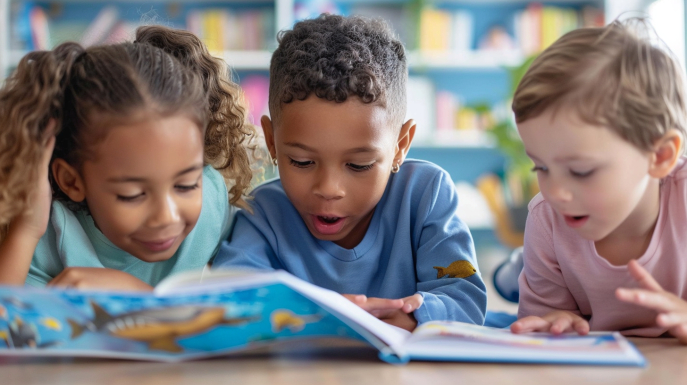5th Apr 2024
Ocean Adventures Await: Top Underwater Creatures Books for Children
Dive into Reading
The Importance of Ocean Books
Ocean-themed literature plays a pivotal role in children's education, serving as a gateway to the vast underwater world. Books about marine life not only entertain young minds but also impart crucial knowledge about the planet's aquatic ecosystems. Springer highlights that children's picture books about the ocean can effectively deliver marine concepts, increase environmental awareness, and promote a positive attitude towards science. They expand children's perceptions of scientists and may even influence future career aspirations. These narratives are not just stories; they are tools that can shape young readers' beliefs and perceptions about science and the role of scientists in society.
For parents seeking to educate their children about the ocean, children's books about the ocean offer a diverse range of topics, from books about sharks for kids to mermaid books for kids, each providing a unique perspective on ocean life.
Selecting Age-Appropriate Material
Choosing the right ocean book for a child is essential. It's important to match the material with the child's reading level and cognitive development. For toddlers and preschoolers, ocean picture books for toddlers with vibrant illustrations and simple text can capture their imagination. As children grow, they may engage with ocean-themed storybooks for children that introduce more complex narratives and characters.
Interactive options such as ocean puzzles books for children and ocean-themed activity books for kids can keep active learners engaged. For those with a keen interest in marine life, ocean animals books for kids provide factual information in an accessible format.
Older readers may gravitate towards ocean exploration books for children or ocean conservation books for kids that delve deeper into ecological issues and scientific exploration. Ocean science books for kids can cater to curious minds looking to understand more about oceanography and marine biology.
Selecting age-appropriate material ensures that children are not only able to comprehend the content but also find enjoyment and inspiration in what they read. It's through this tailored approach that books about the undersea realm can truly make a lasting impact on young readers' lives.
Sensory Board Books
Introducing young readers to the wonders of the ocean can be a delightful and educational experience. Sensory board books, designed with the tactile needs of toddlers in mind, are an excellent way to engage the youngest readers with the marvels of underwater life.
Engaging the Youngest Readers
Sensory board books are crafted to stimulate the senses of young children, making them a perfect introductory medium to the expansive world beneath the waves. Titles like "Silly Sea Creatures Sensory Silicone Touch and Feel Board Books" offer a hands-on reading experience that can captivate toddlers with textures representing the unique feel of sea creatures like a singing starfish or an organized octopus (Creative Therapy Store).
These books often combine bright, vivid images with interactive elements such as flaps and varied textures. This combination not only holds the attention of young readers but also nurtures their early cognitive development. Engaging board books about ocean animals, marine life, and seashore discoveries can ignite a child's curiosity about the natural world.

Benefits of Sensory Interaction
Sensory interaction plays a crucial role in a child's development. The tactile elements in sensory board books help to develop fine motor skills as little fingers explore different surfaces. This active engagement with the book's features encourages children to associate reading with a fun and immersive experience.
Moreover, sensory books offer an early introduction to marine biology and oceanography in a format that's accessible to toddlers. For example, "Hello, World!" is a series that introduces young readers to nonfiction concepts, including marine life, in an age-appropriate manner (Elementary Librarian). These books often feature simple text accompanied by colorful illustrations that can help children learn basic facts about the ocean and its inhabitants.
The benefits of integrating sensory interaction with educational content are clear. It not only encourages a love for reading from an early age but also plants the seeds of interest in oceanography and environmental preservation. As children grow, these early interactions can influence their perceptions of science and the natural world, potentially inspiring the next generation of ocean explorers and conservationists.
For parents looking to dive deeper into the selection of sensory board books, titles such as "Babies in the Ocean Lift-a-Flap" and others found in ocean-themed storybooks for children offer a vibrant and imaginative world filled with friendly sea animals that are sure to enchant and educate young minds.
Picture Books and Storytelling
Visual Learning and Imagination
Picture books serve as a magical gateway into the underwater realm, fostering visual learning and imagination among young readers. The vivid illustrations and narratives found in picture books about the ocean are not just entertaining; they are instrumental in building a child's ability to visualize and understand the world around them. For instance, "The Big Book of Blue" by Yuval Zommer offers an incredible journey of discovery, presenting life under the sea through a tapestry of bizarre creatures and scaly sharks that will leave children in awe (Elementary Librarian).
The colourful and detailed artwork in these books captures the attention of young readers, drawing them into stories that are both educational and captivating. As children flip through the pages, they not only absorb information but also develop a keen appreciation for the beauty of marine life. This form of learning is particularly impactful for visual learners, who can better grasp concepts when they are accompanied by images.
Environmental Messaging
Incorporating environmental messages into storytelling is a subtle yet powerful method of educating children about the importance of ocean conservation. Books that weave these themes into their narratives help instil a sense of responsibility towards marine habitats from an early age. "Babies in the Ocean Lift-a-Flap" board book, for example, introduces young readers to a cast of friendly sea animals and, in doing so, creates a connection between children and the creatures they are learning about (Elementary Librarian).
Through storytelling, authors can address complex topics such as pollution, overfishing, and climate change in a manner that is accessible and engaging for children. The stories often feature protagonists who take action to protect the ocean, providing role models for young readers to emulate. These narratives are not only educational but also motivational, encouraging children to think about their own role in preserving the underwater world.
In conclusion, picture books are an essential component in nurturing a child's love for reading and learning about the underwater world. With their blend of visual stimulation, imagination, and environmental messaging, these books are key to introducing young minds to the wonders and challenges of the ocean. Parents looking to spark an interest in marine life can find a treasure trove of underwater creatures books for children that are both enjoyable and enlightening.
Non-Fiction Titles for Curious Minds
Providing children with educational books about the ocean and its inhabitants is crucial for sparking interest in marine life and fostering a deeper understanding of our planet's ecosystems. Non-fiction books serve as an excellent medium for introducing marine biology and ocean geography to young, inquisitive minds.
Introducing Marine Biology
Marine biology is a fascinating subject that delves into the diverse species and ecosystems found within the ocean’s depths. Books that introduce this field to children often combine striking visuals with engaging facts to captivate their imagination and encourage further exploration.
One standout title is "Earth’s Incredible Oceans" by Jess French, which offers an in-depth look at marine animals, their habitats, and ecological concepts like food webs, tailored for children aged 7-9 years. The book's engrossing illustrations and content are suitable for a wide age range, making marine biology accessible and enjoyable for all young readers (Discover Wildlife).
"Creature Features: Oceans" by Natasha Durley groups together an array of amazing marine creatures, using bold and vivid artwork to draw in children aged 5 and up. This book provides an excellent opportunity for kids to become acquainted with marine life.
For those interested in discovering more about the underwater realm, explore our collection of marine life books for kids and ocean science books for kids.
Exploring Ocean Geography
Understanding the geography of the ocean is key to comprehending how marine ecosystems function and interact with the rest of the world. Books that explore this topic can take children on a journey through the vast and varied landscapes beneath the waves.
"The Great Barrier Reef" by Helen Scales is an exemplary book aimed at children aged 5-7 years. It takes readers on a voyage through the reef's natural and human history, embedding conservation messages within its beautifully illustrated pages that reveal the underwater world’s secrets (Discover Wildlife).
"Water World" by Ben Rothery not only introduces children to ocean life but also connects it to human life, underscoring the fragility of our oceans. The book is packed with detailed illustrations, including depictions of some of the more unusual species, making it a visual feast for kids who are passionate about marine life (Discover Wildlife).
Delve deeper into the subject with our curated list of oceanography books for kids and ocean geography books for children, which provide a wealth of knowledge on the subject.
Non-fiction books for children play a vital role in igniting curiosity and understanding of the ocean. They lay the groundwork for a lifetime of learning and appreciation for the marine environment. Encouraging young readers to explore these books can lead to a greater awareness of our oceans and inspire the next generation of marine biologists and conservationists.
Interactive Books for Active Learning
Interactive books can play a pivotal role in developing a child's enthusiasm for learning about marine life. Such books employ various formats designed to stimulate active participation and deepen understanding of the subject.
Question-and-Answer Formats
Books that feature a question-and-answer format are particularly effective at engaging young readers. They stimulate curiosity and encourage children to think critically about what they are learning. An excellent example of this type of book is the nonfiction picture book "Ocean Animals from Head to Tail," which introduces various ocean creatures through a playful guessing game. Readers are shown a close-up illustration of a unique part of an animal's body and asked to guess which creature it belongs to. This approach not only makes the learning process interactive but also fun.
Question-and-answer books often include lively illustrations and captivating cartoons, enhancing the visual appeal and making the content more accessible. These types of books are not just informative but also entertaining, ensuring that young readers remain engaged and eager to turn the page (Elementary Librarian). For more recommendations on engaging ocean-related books, visit our curated list of best ocean books for kids.

Lift-the-Flap Discoveries
Lift-the-flap books are another interactive format that can captivate children's attention and foster an active learning environment. Hidden behind flaps are images of intriguing underwater creatures, waiting to be discovered by curious little hands. This type of book typically combines whimsical rhymes and interactive elements, such as peekaboo flaps, to create a sense of adventure and surprise with each turn of the page.
One of the many benefits of lift-the-flap books is that they encourage children to explore and interact directly with the content, which can enhance their retention of information and stimulate their imagination. These books are a great way to introduce young readers to the enchanting world beneath the waves, making them ideal for early learning experiences.
Interactive books, whether they employ question-and-answer formats or lift-the-flap features, are an excellent way to engage children in the wonders of marine life. They provide a hands-on approach to learning that can help foster a lifelong interest in the ocean and its inhabitants. For an array of engaging and educational titles, explore our selection of interactive ocean books for kids.
Novels for Young Adults
As children transition into young adulthood, their reading preferences often evolve to include more complex narratives and themes. Novels that incorporate the ocean and its myriad creatures offer a unique opportunity to blend education with entertainment, nurturing a lifelong interest in marine science and environmental conservation.
Fiction's Role in Ocean Education
Fiction plays a pivotal role in ocean education by weaving factual information into compelling storylines. It can captivate readers who might not be naturally inclined to pick up nonfiction titles about marine environments. For instance, novels that feature underwater expeditions or the lives of ocean inhabitants can subtly impart knowledge while telling an engaging story.
According to Five Books, fiction books are a fantastic medium for connecting young readers to the ocean. They can be particularly alluring for those who may not instinctively reach for nonfiction books about the sea and sea creatures. For young adults, these stories can serve as a gateway to deeper interest and understanding of marine life and ecosystems.
Spotlight on Adventure and Mystery
Adventure and mystery are genres that naturally complement stories set in the vast, uncharted waters of the oceans. Books that spotlight these elements can capture the imagination of young readers, offering thrilling escapades among coral reefs, shipwrecks, and deep-sea trenches.
Notable recommendations for this age group include "Between Sea and Sky" by Nicola Penfold, "The Song That Sings Us" by Nicola Davies, "Blueback" by Tim Winton, "Nation" by Terry Pratchett, and "Skin of the Sea" by Natasha Bowen. These novels, suggested by Five Books, are perfect for children and young adults between the ages of 10 and 14. This age range is crucial for maintaining and expanding young readers' interest in nature and the ocean, with fiction storytelling being a powerful tool for such engagement.
By exploring ocean-themed storybooks for children, young adults can embark on imaginary voyages that highlight the awe-inspiring beauty and complexity of oceanic life. Furthermore, these narratives often underscore the importance of ocean conservation, inspiring readers to become stewards of the natural world.
In conclusion, novels with themes of adventure and mystery set in marine environments can significantly contribute to a young adult's education about the ocean. They offer an enjoyable way to learn about underwater ecosystems while fostering a love for reading and an appreciation for the vast blue seas.

Educational Impact of Marine Literature
Marine literature, particularly aimed at younger audiences, can play a significant role in shaping perceptions and enhancing education about the ocean. With a range of underwater creatures books for children available, these resources can influence how children view science and the natural world around them.
Influencing Perceptions of Science
Marine-themed children's books are more than just a source of entertainment; they can mould children's beliefs and perceptions about science, including what it means to be a scientist. According to research from Springer, the portrayal of scientists in picture books, especially female scientists, can widen children's views on who can be a scientist and how scientific work is conducted. This is crucial in a world where diversity in science fields is actively encouraged.
Furthermore, such literature can inspire children to explore scientific fields further, potentially impacting their future career choices. By featuring marine biologists and oceanographers in storytelling, ocean-themed storybooks for children can stimulate a child's interest in these professions from an early age.
Enhancing Classroom Learning
Marine literature also serves as a valuable educational tool for teachers. Picture books about the ocean can reinforce teachers' understanding of marine science concepts and enhance their confidence in using these books as educational resources (Springer). These books can deliver complex oceanic concepts in a format that is accessible and engaging for children, increasing awareness of the local marine environment and promoting a positive attitude towards science.
In Australian primary schools, a review suggested the use of 91 ocean-themed picture books to teach marine science concepts, highlighting the potential of these resources in educational settings. By integrating educational ocean books for kids into classroom learning, teachers can create an immersive experience that encourages students to learn about marine life, ocean geography, and the importance of conservation.
Books like ocean exploration books for children, marine life books for kids, and ocean science books for kids are not only tools for imparting knowledge but are also instrumental in developing a child's lifelong interest in the ocean and its preservation. Through engaging narratives and interactive elements, these books can significantly contribute to a child's educational journey and their understanding of the world beneath the waves.
Advanced Readers and Ocean Exploration
For children who have developed a stronger reading ability, advanced books about ocean exploration can provide a thrilling educational experience. These titles often delve deeper into the subject matter, allowing young readers to enhance their understanding of marine science and geography.
Navigating Scientific Vocabulary
Advanced readers are ready to tackle the more complex language of scientific vocabulary found in many ocean exploration books. These texts introduce terms that describe the varied aspects of marine life, from the anatomy of sea creatures to the physical properties of oceanic environments. For example, "The Sea Below My Toes" captivates young readers with language and vocabulary beneficial for expanding their lexicon, recommended for teaching kids how to research a topic (NetGalley).
By navigating through scientific terms, children not only learn about underwater creatures but also the processes and elements that make up their ecosystems. Books such as these often contain a glossary or a list of terms, which can be a helpful tool for readers to reference and reinforce their learning.
Understanding Oceanic Zones
Understanding the different oceanic zones is crucial for young explorers to comprehend the vastness and diversity of the ocean. Advanced books for children often take readers on a journey through these zones, introducing them to the unique sea life found at various depths. "The Sea Below My Toes" is praised for its comprehensive exploration of ocean zones and the creatures that inhabit them, making it a perfect addition to an ocean unit or for recreational reading (NetGalley).
To further engage readers, some books use semi-realistic watercolor illustrations to showcase both familiar and unfamiliar creatures. The combination of engaging text and vivid illustrations helps to bring the underwater world to life, fostering a deeper appreciation for marine biology and encouraging future learning.
In choosing books for advanced readers, parents and educators can look for titles that offer both a considerable amount of information and an age-appropriate approach to learning about the ocean. These books can be an excellent resource for enhancing classroom learning or for children who have a keen interest in ocean exploration and marine life. Additionally, such books often include interactive elements, such as close-up illustrations or guessing games, as found in "Ocean Animals from Head to Tail," which encourages active participation and makes learning about the ocean an immersive experience (Kids Can Press).
Advanced readers who immerse themselves in the world of ocean exploration through reading can develop a comprehensive understanding of the subject. These books not only provide knowledge but also inspire a sense of adventure and a desire to learn more about the mysteries of the deep sea.

